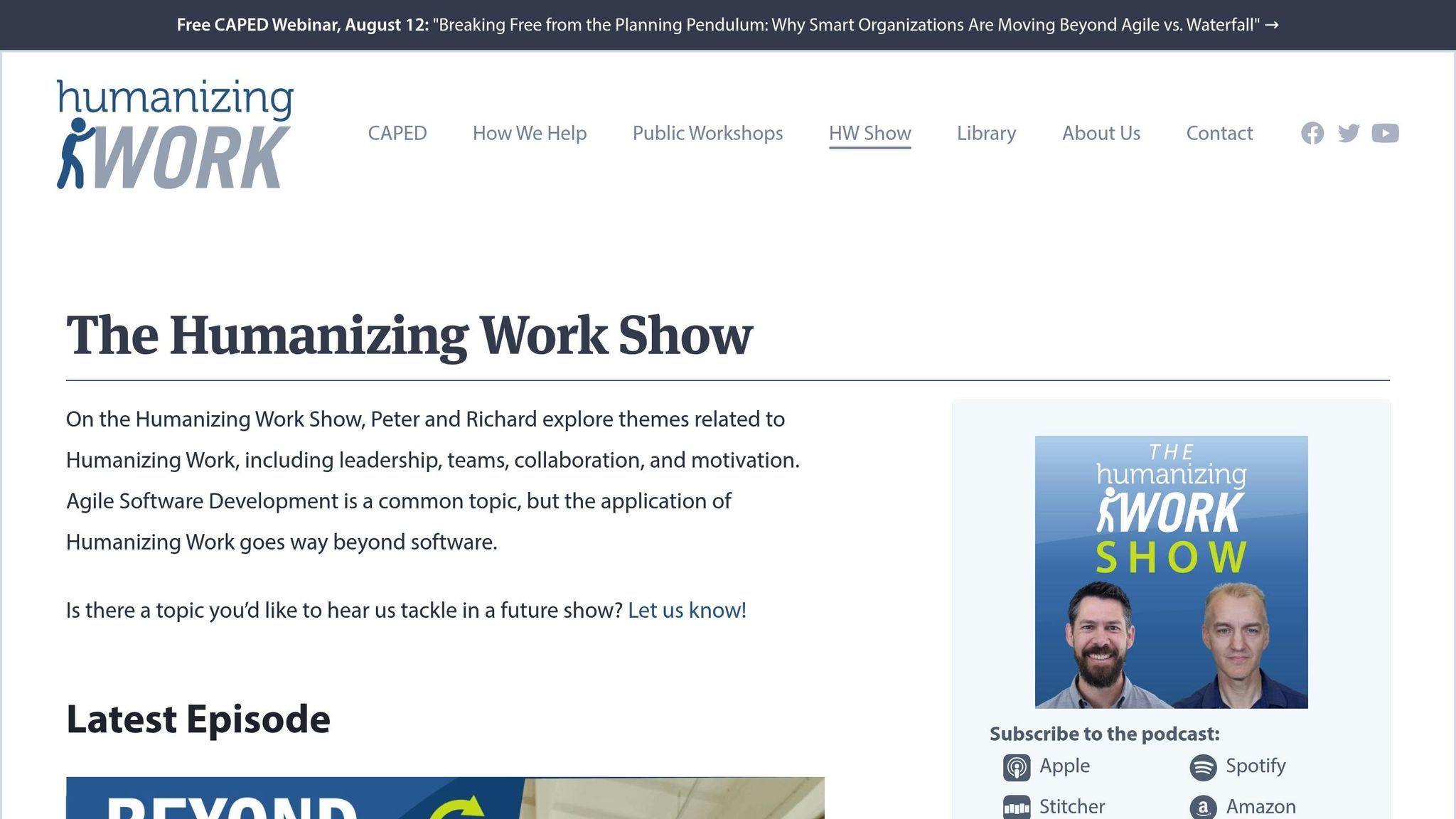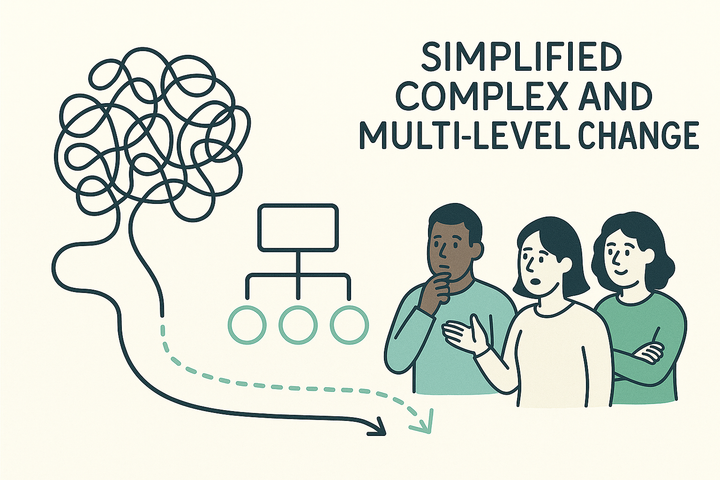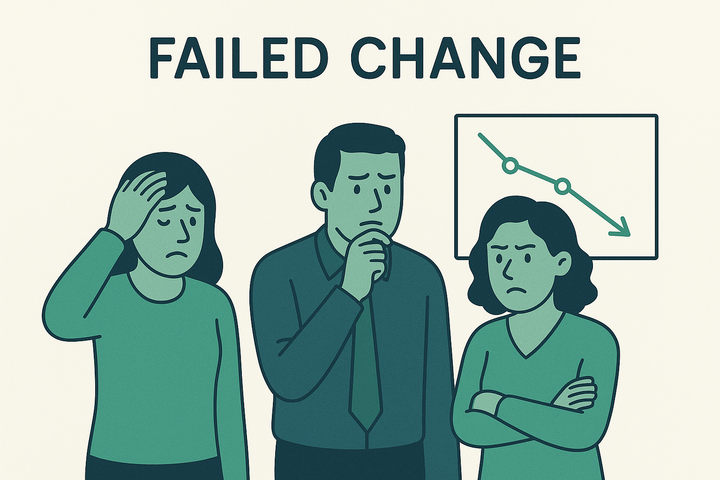Collaborative Communication in Change Management
Explore how collaborative communication can enhance change management by fostering employee engagement, trust, and innovative solutions.

Collaborative communication can transform how organisations navigate change. Unlike top-down or one-way approaches, it actively involves employees in discussions, fostering engagement and trust. This method reduces resistance, boosts morale, and leads to better solutions by leveraging collective input. However, it can slow decision-making if not managed well.
Key takeaways:
- Collaborative communication: Encourages two-way dialogue, increases engagement, and builds trust.
- Top-down communication: Efficient for urgent decisions but risks disengagement.
- One-way communication: Effective for updates but lacks feedback channels.
- Consultative communication: Balances employee input with leadership authority, improving alignment.
Each approach has its place, but collaborative communication stands out for complex changes, ensuring employees feel valued and invested in the process.
How to Make Change Management Joyful and Collaborative | Humanizing Work Show

1. Collaborative Communication
Collaborative communication reshapes how organisations manage change by actively involving employees in discussions, rather than merely delivering instructions. This method acknowledges that successful transformation isn’t just about compliance; it’s about fostering genuine engagement and shared responsibility.
Engagement Level
Collaborative communication takes employee engagement to a whole new level. Unlike traditional methods that treat employees as passive recipients of instructions, this approach actively involves them in shaping the change process. Research from Prosci highlights that employee engagement is one of the top three factors contributing to the success of organisational change. When employees feel involved, they take ownership, which significantly reduces resistance. Transparent communication plays a key role here - it builds trust, alleviates uncertainty, and ensures everyone is on the same page.
The numbers speak for themselves: organisations that create collaborative environments see up to a 30% boost in employee engagement. Moreover, companies that prioritise collaboration are five times more likely to achieve high performance. The secret? Involving employees not just in the execution phase, but also in planning and problem-solving.
Feedback Mechanism
A strong feedback system is another cornerstone of collaborative communication. This approach relies on meaningful, two-way conversations that encourage employees to share their input, concerns, and suggestions throughout the change process. It’s not just about talking - it’s about listening. Research shows that employees who receive meaningful feedback weekly are 80% more engaged, and those regularly praised or recognised see a 10–20% productivity boost.
"The heart of effective change management is regular communication. Most organisations understand the importance of consistently communicating where you're at, where you're going, and how you will get there. But many companies forget that an essential part of communication is listening." – Didier Elzinga, Founder & CEO, Culture Amp
Effective feedback mechanisms include regular pulse surveys, structured listening sessions, and informal check-ins. These tools gather real-time insights into employee sentiment. But it doesn’t stop at collecting feedback - it’s equally important to show how this input shapes decisions and drives the change process forward.
Leadership Role
Leadership is the glue that holds collaborative communication together. For this approach to succeed, leaders must move away from traditional command-and-control styles. Instead, they should adopt a more facilitative role, focusing on shared goals, open dialogue, and mutual respect. This leadership style fosters inclusivity and encourages collective problem-solving.
Collaborative leaders operate with trust, clarity, and a sense of shared purpose. They prioritise influence over authority and transparency over control. While sharing decision-making power can be challenging, the benefits are undeniable. By tapping into the collective wisdom of their teams, leaders can inspire deeper commitment to change initiatives. To lead effectively in this context, leaders must model the collaborative behaviours they wish to see - seeking input, acknowledging uncertainties, and showing how employee contributions shape decisions.
Effectiveness in Complex Change
Collaborative communication proves especially valuable in navigating complex organisational changes. These transformations often involve interconnected systems, diverse viewpoints, and a degree of uncertainty - all areas where collaboration thrives. This approach leverages the distributed knowledge within the organisation, drawing on the insights of employees who are closest to day-to-day operations. Their perspectives can reveal potential challenges and spark innovative solutions that leadership might overlook.
In certain cases, such as when time is critical or confidentiality is required, a top-down approach may be necessary. However, for most complex transformations, collaborative communication stands out. It reduces resistance, boosts engagement, and leads to better-quality solutions. This method is particularly effective when changes impact daily workflows, demand new behaviours, or challenge deeply ingrained organisational norms.
2. Top-down/Directive Communication
Top-down communication follows a traditional, hierarchical model where information flows from senior leadership down through the ranks. Decision-making is centralised at the top, ensuring that employees receive consistent and unified messages about organisational goals and changes.
Engagement Level
In this approach, employees primarily serve as information recipients. Studies indicate that 52% of employees perceive communication within their organisations as largely one-directional, originating from leadership. While 59% of employees report feeling proud when leaders communicate clearly during organisational changes, there’s a flip side. Clear and consistent messaging can boost commitment, with employees being 65% more likely to align with company objectives. However, this method can also leave employees feeling disconnected from the decision-making process, potentially leading to resistance, low morale, and limited engagement.
Feedback Mechanism
Top-down communication often lacks robust feedback channels. The one-way nature of this model can create blind spots, as valuable insights from frontline employees are frequently overlooked. Without effective mechanisms for feedback, organisations risk missing out on the practical and experiential knowledge that employees bring to the table. This absence of feedback loops can make top-down strategies rigid, reducing their ability to adapt to unexpected challenges or shifting circumstances.
"People are people - carbon and water. As such, we resist change. It's important to recognise that managing change is about upsetting people only at a rate that they can tolerate. It's all about physics. For change, there must be movement. With movement, there is friction." – David A. Shore, Instructor at Harvard DCE
Leadership Role
Leaders in a top-down model take on a directive role, making decisions and ensuring that goals are communicated clearly across all levels. Consistency and transparency in their messaging are crucial for building trust and maintaining alignment. While this approach helps leaders inspire employees and outline a clear vision for change, it relies heavily on their ability to motivate and plan effectively. However, this leadership style tends to prioritise directives over collaboration or innovation, which can limit the inclusivity of the change process.
Effectiveness in Complex Change
Top-down communication works particularly well in situations requiring quick, decisive action. Organisations with structured communication protocols can reduce decision-making time by as much as 40% compared to those without such systems. This efficiency is advantageous for driving focus in transformational initiatives. Yet, relying solely on this approach may not suffice for complex organisational changes. These often require input from diverse perspectives and adaptability to navigate the challenges of evolving workflows and behaviours. The rigidity of top-down methods can become a barrier when practical insights from employees on the ground are not integrated, underscoring the need for more participative approaches in such scenarios. This contrast sets the stage for exploring alternative communication models in the following discussion.
3. One-way Informative Communication
One-way communication follows a straightforward path: information flows from the sender to the receiver, with little room for interaction or feedback. While this structure works well for quickly sharing updates with large groups, it falls short when applied to change management, where engagement and adaptability are critical.
Engagement Level
This approach is designed to deliver information, but it often leaves employees feeling like passive observers rather than active participants. Without opportunities to ask questions, voice concerns, or share ideas, employees may feel detached from the process, which can weaken the success of change initiatives. According to research by Prosci, employee engagement ranks among the top three factors for successful change. Yet, when communication is one-sided, it risks alienating employees. McKinsey & Co. highlights this issue, noting that 70% of organisational change efforts fail - a stark reminder of the need for more interactive communication strategies.
Feedback Mechanism
Another major drawback of this method is the absence of feedback channels. Without a way to assess whether messages are understood or to gauge employee sentiment, misunderstandings can arise, and trust can erode. High-performing organisations address this by integrating two-way feedback systems, which allow them to respond more effectively to changes in the market. Research shows that these organisations outperform others in responsiveness, with a 65% success rate compared to 41% for those lacking such systems.
Leadership Role
In one-way communication, leaders tend to take on a directive role, focusing on delivering clear and consistent messages. While this ensures alignment, it limits their ability to understand how employees are feeling or reacting to the change. Prosci's methodology suggests that leaders should tailor messages to their audience and repeat them frequently to minimise misinformation.
"No one says they learned about a change too early. But many people say they've learned about a change too late."
- Michelle Haggerty, Chief Operating Officer, Prosci
Leaders must act quickly to share information, as delays can lead to rumours and confusion. However, the challenges of this top-down approach make it less effective in navigating the complexities of organisational change.
Effectiveness in Complex Change
While one-way communication works well for straightforward updates, it struggles in situations requiring deeper behavioural shifts. Complex changes demand input from multiple perspectives and the ability to adapt strategies based on real-time feedback. Many organisational change efforts fail due to poor internal communication, highlighting the limitations of this approach. To succeed in driving meaningful change, organisations must pair one-way communication with more interactive methods that foster trust and collaboration.
4. Consultative/Participative Communication
Consultative communication strikes a balance between directive and fully collaborative styles. Leaders actively seek input and feedback from employees and stakeholders while retaining the final decision-making authority. This approach acknowledges the valuable insights employees bring to change initiatives but stops short of granting them equal say in creating solutions. Instead, it combines employee contributions with decisive leadership to tackle the challenges of organisational change effectively.
Engagement Level
This method significantly boosts employee engagement by involving them in the change process. When organisations consult their workforce, employees gain a clearer understanding of the changes and are more likely to support them. This sense of inclusion fosters trust and reduces resistance, making transitions smoother. Moreover, employees tend to feel more at ease as they adapt to new practices when their input is valued.
However, there's a notable gap in execution. While 82% of leaders claim they have strategic alignment, only 23% actually achieve it, highlighting potential shortcomings in consultation efforts. This gap underscores the importance of not just involving employees but doing so in a way that meaningfully aligns their insights with organisational goals.
Feedback Mechanism
A key feature of consultative communication is its structured and continuous feedback loops, which help refine strategies throughout the change process. It’s not enough to simply gather feedback - leaders must actively listen and respond. Research shows that employees who feel their voices are heard are nearly five times more likely to give their best effort at work.
To maximise this advantage, organisations should embed feedback mechanisms at every stage of change: preparation, management, and reinforcement. Using a variety of channels - such as surveys, focus groups, and small group discussions - encourages open and honest dialogue. Leaders must then show they value this input by addressing concerns, answering questions, and implementing visible changes when possible.
Leadership Role
In this model, leaders must balance authority with approachability. Their role involves assessing resources, addressing employee needs, and communicating clear, motivating goals. Transparency and authenticity are essential for building trust. Leaders also need to listen carefully, ensuring their messages are understood and identifying any concerns that arise.
Creating a culture where employees feel safe to provide honest feedback is critical for fostering innovation and implementing change successfully. Leaders must model the behaviours they want to see, provide accurate information about the scope of change, and ensure employees have the tools and resources needed to succeed.
Managing expectations is a crucial challenge. Employees need to understand that while their input is valued and will influence decisions, the ultimate authority rests with leadership. Clear communication about how feedback will be used - and what influence employees can expect - is vital for maintaining trust.
Effectiveness in Complex Change
Consultative communication is particularly well-suited for complex change scenarios that require diverse perspectives but also demand decisive leadership. This approach works best when external conditions are stable enough to allow time for gathering and processing feedback from stakeholders. It combines the collective wisdom of employees with the speed and clarity needed to navigate complex changes.
What makes this method effective is its ability to address both the rational and emotional dimensions of change. As Christian Buckley, Microsoft Regional Director, explains:
"The more you involve people in the process, the more likely they are to accept the end result."
By involving employees, organisations help them understand not only what is changing but also why it is necessary and how they fit into the new framework.
That said, consultative communication needs careful handling to avoid pitfalls like consultation fatigue or the perception that feedback is being ignored. Leaders must act on employee input where possible and, when suggestions can’t be implemented, provide clear explanations to maintain trust and engagement.
Advantages and Disadvantages
Every communication approach in change management comes with its own benefits and challenges. By weighing these trade-offs, leaders can select the method that best suits their goals and circumstances. Below is a closer look at how these approaches compare across different scenarios.
Collaborative communication thrives on tapping into collective intelligence and fostering genuine buy-in. It enhances work quality by incorporating peer reviews and diverse viewpoints, while promoting creativity through the exchange of ideas. When employees are involved in decision-making, they feel a stronger sense of ownership and accountability, which leads to organisations that can adjust more effectively to sudden changes. However, while collaboration boosts engagement, it can also slow decision-making. Long feedback loops and over-collaboration may blur roles or suppress critical discussions, delaying progress.
On the other hand, top-down communication is ideal for situations requiring swift and clear decisions. This approach ensures that strategic goals are communicated effectively, helping organisations implement changes without the delays that come with consensus-building. However, while it offers clarity, it can leave employees feeling disengaged, as they may not feel involved in the decision-making process.
Meanwhile, one-way informative communication works well for delivering straightforward directives or urgent updates. It ensures consistency in messaging across the organisation, which is particularly useful in time-sensitive situations. However, the lack of dialogue can lead to misunderstandings and makes this approach less suitable for complex changes that require employee input and adaptability.
Consultative communication offers a balanced approach by actively seeking employee feedback while maintaining leadership control. This method tends to improve engagement compared to purely directive strategies. However, it can also lead to "consultation fatigue", where employees feel overwhelmed by frequent input requests. For instance, a study revealed that 67% of leaders report underperforming transformations, with a stark gap between perceived strategic alignment (82%) and actual alignment (23%), highlighting the challenges of properly managing consultative processes.
| Communication Approach | Engagement Level | Feedback Mechanism | Leadership Role | Effectiveness in Complex Change |
|---|---|---|---|---|
| Collaborative Communication | High | Two-way | Facilitator and Listener | Very Effective |
| Top-down/Directive | Low | Minimal | Authoritative | Limited |
| One-way Informative | Low | None | Informer | Ineffective |
| Consultative/Participative | Moderate | Limited | Guide | Moderately Effective |
These comparisons highlight the importance of tailoring communication strategies to the unique demands of each change initiative. The right approach depends on factors like urgency, complexity, and the expertise required from employees. For example, with 4.3 million employees in the US working remotely at least half the time and over 70 million freelancers, traditional hierarchical structures are increasingly being replaced by flatter models that encourage more open communication.
Ultimately, success lies in aligning the communication style with the specific needs of the change effort. Leaders must consider the context, timing, and organisational dynamics to ensure effective implementation.
Conclusion
Collaborative communication stands out as a highly effective way to navigate the complexities of organisational change. Unlike one-sided or directive approaches, it actively involves employees in decision-making, valuing their input and perspectives. This inclusive method not only encourages shared ownership but also helps to reduce resistance, laying the groundwork for sustainable transformation.
By fostering open dialogue, collaborative communication enhances employee buy-in, clarifies messaging, and leads to more effective solutions. When leaders engage their teams meaningfully, they empower employees to take an active role in the change process, naturally building trust and commitment. The two-way nature of this approach allows organisations to address concerns early and resolve misunderstandings before they escalate into obstacles.
To maximise these benefits, leaders can develop change journey maps that position employees as active contributors rather than passive observers. Establishing open feedback channels is another key step, enabling team members to voice concerns, share ideas, and offer suggestions for improvement. This promotes a culture of responsiveness and continuous learning.
Storytelling also plays a pivotal role in collaborative communication. Stories are far more memorable than facts alone, making them a powerful tool for leaders aiming to inspire and connect with their teams. Leaders can share personal narratives about their own journeys or highlight team achievements to strengthen motivation and foster a sense of unity.
For leaders to truly excel in collaborative communication, qualities like emotional intelligence, authenticity, and adaptability are essential. Active listening, tailoring messages to different audiences, and engaging fully in every interaction are critical skills for building trust and connection.
For those looking to refine these abilities, resources like the Leadership Story Bank offer practical tools to master storytelling and enhance executive presence. These resources help leaders craft meaningful narratives, find their voice, and communicate with clarity - skills that are indispensable for guiding collaborative change efforts.
Ultimately, organisations that embrace collaborative communication are far better equipped to manage change effectively. In contrast, those relying on top-down methods may struggle to achieve the engagement and ownership needed for meaningful, long-term transformation.
FAQs
How can organisations balance the need for swift decisions with the benefits of collaborative communication?
Organisations can find the sweet spot between quick decision-making and inclusive communication by using structured frameworks that streamline workflows without sidelining collaboration. A good starting point is to clearly outline roles and responsibilities. When everyone understands their part in the process, unnecessary delays can be avoided.
Creating an environment for open yet focused discussions is another key step. This approach lets diverse viewpoints surface while keeping the process efficient. Additionally, setting clear expectations about timelines and desired outcomes helps maintain a steady pace, ensuring that teamwork stays aligned with the organisation's objectives.
How can leaders effectively consider and act on employee feedback during organisational change?
Valuing Employee Feedback During Organisational Change
To make sure employee feedback truly counts during times of organisational change, leaders need to prioritise open and honest communication. This means actively listening to what employees have to say, recognising their contributions, and weaving their relevant ideas into the decision-making process. Transparency plays a crucial role here - keep your teams updated on how their input is shaping plans and driving outcomes.
Creating regular opportunities for feedback is equally important. This could involve using tools like surveys, scheduling one-to-one meetings, or hosting team discussions. It’s essential to ensure employees feel comfortable expressing their views, knowing they can do so without fear of judgement or negative consequences. When leaders take visible action based on feedback and close the loop by sharing outcomes, they build trust and encourage a collaborative environment - a vital ingredient for navigating change successfully.
When is a consultative communication approach more effective than a collaborative one during organisational change?
In scenarios where gathering stakeholder input is essential but full collaboration isn't feasible, a consultative approach often proves most effective. This tends to apply in complex or delicate situations where decisions benefit from varied perspectives, yet time or resources limit the scope for deeper collaboration.
By actively seeking feedback and promoting mutual understanding, a consultative approach helps to build trust and ensures stakeholders feel their voices are valued. At the same time, it empowers leaders to make timely, well-informed decisions. This method is especially useful during times of major organisational change, where balancing inclusivity with efficiency is key.



